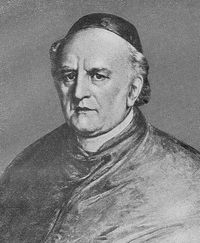Category:Enochic Studies--1800s
Enochic Studies in the 1800s--Works and Authors
< ... -- 1400s -- 1500s -- 1600s -- 1700s -- 1800s -- 1850s -- 1900s -- 1910s -- 1920s -- 1930s -- 1940s -- 1950s -- 1960s -- 1970s -- 1980s -- 1990s -- 2000s -- 2010s -- ... >
Overview
Silvestre de Salcy was the first scholar to publish a translation (in Latin) of portions of the Paris manuscript of 1 Enoch, with notes in French (1800). His notes were translated into German in 1801.
The "rediscovery" of the Ethiopic text deprived the Enoch Fragments of Syncellus of the centrality they had for two centuries in the early Enoch scholarship. Daniele Manin's commentary in 1820 was the last one based on the Enoch Fragments of Syncellus; it remains a testament to two centuries of scholarship on 1 Enoch based on the available Greek, Latin, and Hebrew sources before the recovery of the Ethiopic text, and an even more impressive accomplishment when one considers that the would-be renowned Venetian patriot and statesman, and future president of the reborn Republic of Venice in 1848-49, was then barely sixteen years old.
In 1821 Richard Laurence published the first English translation of the whole 1 Enoch, followed by the editio princeps of the Ethiopic text in 1838. Both works were based on the manuscript at the Bodleian Library. In 1831-33 Eduard Rüppell’s expedition to Ethiopia produced Germany’s first exemplar of the book at the Stadtbibliothek in Frankfurt am Main. Two German translations (Hoffmann, 1833-38; and Clemens, 1850) and a Latin translation (Gfrörer, 1840), contributed to make the book available to the scholarly community.
In the 1820s, Angelo Mai purchased the Enoch manuscript that belonged to the Antonelli Library and made it available for study at the Vatican Library. Mai also published in1844 a new Greek fragment of 1 Enoch he had discovered at the Vatican Library.
In the 1830s and early 1840s, the character of Enoch held a prominent place in the revelations of Joseph Smith, the founder of the Latter-Day Saint movement. In the Life of Moses (6-7) Enoch is introduced as a prophet of repentance, a seer, and the builder of a city "that was called the City of Holiness, even Zion" (7:19).
@2014 Gabriele Boccaccini, University of Michigan
Pages in category "Enochic Studies--1800s"
The following 17 pages are in this category, out of 17 total.
1
- Notice du livre d'Énoch (Notes on the Book of Enoch / 1800 Silvestre de Sacy), book
- Nachricht das Buch Henoch betreffend = Notice du livre d'Énoch (Notes on the Book of Enoch / 1801 @1800 Silvestre de Sacy / Rink), book (German ed.)
- The Book of Enoch (1821 Laurence), book
- Georgius Syncellus et Nicephorus Cp. (1829 Dindorf), book
- Das buch Henoch in vollständiger uebersetzung mit fortlaufendem commentar (1833-1838 Hoffmann), book
- Anacalypsis (1836 Higgins), arch-fi book
- Enoch restitutus (1836 Murray), book
- Libri Enoch prophetae versio aethiopica (1838 Laurence), book
- Prophetae veteres pseudepigraphi (Ancient Prophets Pseudepigrapha / 1840 Gfrörer), book
- Christology of the Book of Enoch, with an Account of the Book Itself, and Critical Remarks upon It (1840 Stuart), essay
- Novae patrum bibliothecae (1844 Mai), book
- Enoch & Enoch, Book of (1845 Davidson), essay
Media in category "Enochic Studies--1800s"
This category contains only the following file.
- 1820 * Manin.jpg 138 × 200; 7 KB

